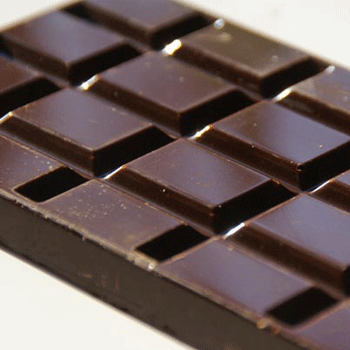Tasty for humans toxic for dogs.
Although many of us enjoy chocolate, this tasty treat is toxic to dogs. Chocolate ingestion often results in significant illness, and if the dog eats enough, it can be fatal!! If your dog eats chocolate it is crucial to know what to do. Read more... Chocolate is toxic because it contains the alkaloid theobromine. Theobromine is similar to caffeine and is used medicinally as a diuretic, heart stimulant, blood vessel dilator, and a smooth muscle relaxant. Theobromine can be poisonous in large amounts. Here is some important information about this potentially fatal toxin to dogs. 
How much chocolate is poisonous to a dog?
Toxic doses of theobromine are reported to be about 100 mg/kg (approximately 50 mg/lb) and fatalities occur at around 200 mg/kg (approximately 100 mg/lb). However, the ASPCA poison control center reports that as little as 20 mg/kg (or 10 mg/lb) can cause signs of illness.
"The amount of toxic theobromine varies with the type of chocolate."
The amount of toxic theobromine varies with the type of chocolate . Cooking or baking chocolate and high quality dark chocolate contains are most concentrated (and thereforemost dangerous), contain between 15-20 mg of theobromine per gram of the . product while milk Milk chocolate such as that found in chocolate bars only contains containingabout 1.5 mg/g. mg/g(miligram per gram) This means that a healthy small dog, weighing ten pounds (4.5 kg), could show signs of mild illness if itate 1/6 oz (5-6 g) of baking chocolate; it would only have to eat one ounce (28 g) of baking chocolate or twelve ounces (330 g) of milk chocolate to potentially show signs of poisoning. A larger dog, weighing fifty pounds (23 kg), could show signs of illness if it ate about an ounce of baking chocolate, but the toxic dose for this size of dog would be around five ounces (140 g) of baking or dark chocolate or 3.5 pounds (1.5 kg) of milk chocolate and would have to eat twenty ounces of baking or dark chocolate to become ill.
However, the toxic dose of chocolate for a pet that is older or has other health problems will be lower (i.e. a dog with a pre-existing illness or a geriatric dog may be more sensitive to the effects of theobromine).
What are the clinical signs of chocolate poisoning?
Clinical signs depend on the amount and type of chocolate ingested. In older pets that eat a large amount of high quality dark or baking chocolate, sudden death from cardiac arrest may occur, especially in dogs with preexisting heart disease. For many dogs, the most common clinical signs are vomiting and diarrhea, increased thirst, panting or restlessness, excessive urination, muscle spasms and occasionally seizures. An elevated heart rate and abnormal behavior are also common.
Clinical signs of chocolate poisoning can take up to twelve hours to develop. Once theobromine is absorbed into the body, it may remain in an active form for up to twenty-four hours. It is important to seek medical attention as soon as you suspect that your dog has eaten chocolate.
Are there other problems associated with eating chocolate?
Yes. If the product contains a high amount of fat or a lot of sugar, it can trigger a bout of acute pancreatitis, an inflammatory condition of the pancreas. Symptoms of pancreatitis include nausea, vomiting, fever, lethargy, abdominal pain, diarrhea and decreased appetite. If acute pancreatitis develops, more intensive treatment will be needed.

What should I do if my dog eats chocolate?
Since chocolate is potentially toxic to dogs, you should have your pet examined by a veterinarian immediately. The very first thhing you should do is contact the ASPCA Animal Poison Control Center at 888 - 426 - 4435. There is a charge for the phone call, but it is well worth it (currently $65). They will take basic information from you about your dog's body weight and the amount of chocolate consumed. Advise will be given, and a case number will be formed, which will help your veterinarian when you bring your pet in, hopefully right away !! The sooner the theobromine is removed from the body or the pet is stabilized, the better your dog's prognosis.
What is the treatment for chocolate poisoning?
Treatment depends on the amount and type of chocolate eaten. If treated early, removal of the chocolate from the stomach by administering medications to induce vomiting may be all that is necessary. In cases where the chocolate was ingested several hours earlier, activated charcoal may be administered to block further absorption of theobromine in the stomach and small intestine. Activated charcoal may be administered every four hours for the first twenty-four to thirty-six hours to reduce the continued resorption and recirculation of theobromine.
It is very common to provide supportive treatments such as intravenous fluid therapy to help dilute the toxin and promote its excretion. All dogs ingesting chocolate should be closely monitored for the first twenty-four hours for any signs of irregular heart rhythm.
If there is evidence of acute pancreatitis, your dog may require more intensive treatment.
I saw a treat made for dogs that contained chocolate. Isn't that dangerous?
Many gourmet dog treats use carob as a chocolate substitute carob looks similar to chocolate and the two are often confused. Some specialty dog bakeries will use a small amount of milk chocolate in their treats. Since the amount of theobromine is so low in milk chocolate, this may be safe for most dogs. However, most veterinarians recommend that you avoid giving your dog chocolate in any form.
If you enjoy eating or cooking with chocolate, particularly if you are a fan of dark chocolate, you should be extremely careful to keep these products out of reach of your pet.
Additional info:
Foods Harmful to Your Pet
ASPCA Poison Control
Plants Poisonous to Dogs & Cats
